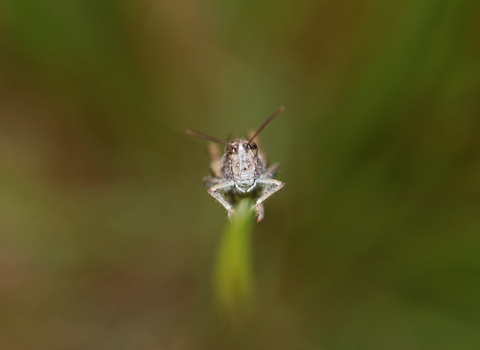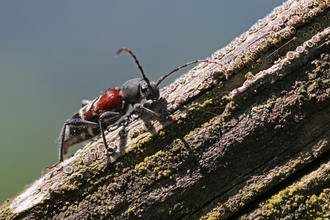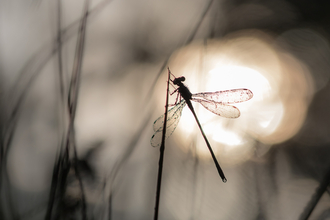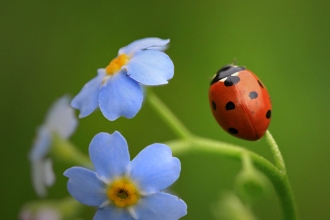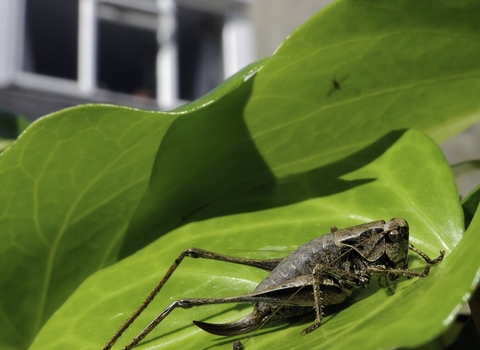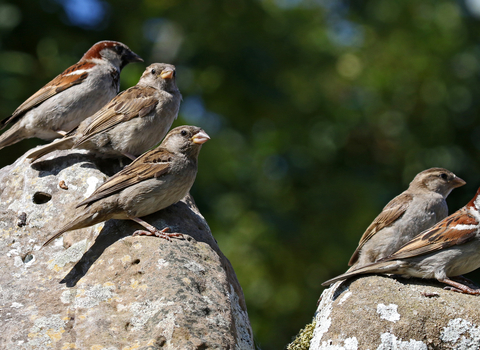Most people will instantly recognise these long-legged creatures whose rattling songs conjure up memories of the sunny summer days of childhood. With help from Gary Farmer, grasshopper and cricket expert and author of Worcestershire's Orthoptera Atlas, discover more about these fascinating and varied insects.
Grasshoppers and bush-crickets belong to an order of insects called Orthoptera, which means straight-wings and describes their long straight outer wings. They are not as common as they once were but they are still doing very well in many parts of the county where grass is allowed to grow, away from chemical sprays - look in nature reserves, areas of open scrubland, heathy grassland, wide roadside verges and river banks.
There are now more species of grasshoppers and bush-crickets in the county than ever before - six species of grasshoppers and eight species of bush-crickets have been found in Worcestershire.
Give our grasshoppers & crickets a boost and take Action for Insects. Pledge to take Action for Insects www.worcswildlifetrust.co.uk/action-insects
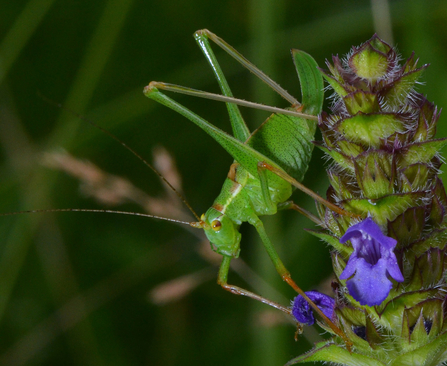
Speckled bush-cricket by Gary Farmer
Speckled bush-cricket Leptophyes punctatissima
A dumpy, dark green bush-cricket with spindly legs and very long thin antennae (a character of all the bush-crickets). Bush-crickets hatch from eggs in late April/early May and the speckled bush-cricket sits quite openly on a leaf soaking up the spring sun. If you look closely, even at the aphid-sized nymphs you will see they are covered in black spots. This species has very short wings and so cannot fly.
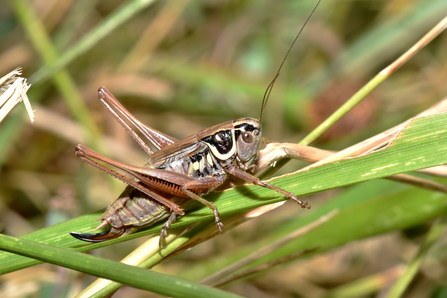
Roesel's bush-cricket by Gary Farmer
Roesel’s bush-cricket Metrioptera roeselii
A distinctive bush-cricket marked with a pale u-shape on the side of the body. Another newcomer to Worcestershire, arriving in 2005 and quickly becoming our commonest bush-cricket. Bush-crickets sing by rubbing their wings together, in this case producing a high-pitched electrical buzz. Its wings are usually half the length of the body but in hot summers long-winged individuals appear that are able to fly, allowing the species to continue its northern advance.
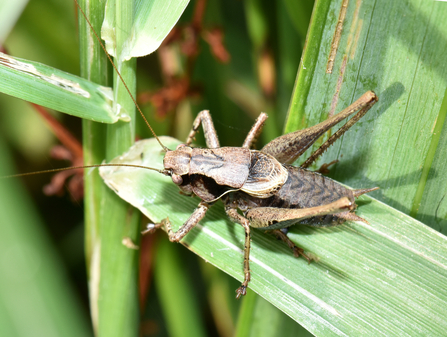
Dark bush-cricket by Gary Farmer
Dark bush-cricket Pholidoptera griseoaptera
Like all bush-crickets, the dark bush-cricket is omnivorous, feeding on vegetation as well as small insects. This is a short-winged species, dark brown in colour and very stocky looking, almost armour-plated. It lives low down in bramble and thick vegetation where its loud ‘click’ call can be heard on warm days into the evening. It is not an urban insect, shunning towns in favour of scrubland and sunny woodland rides.
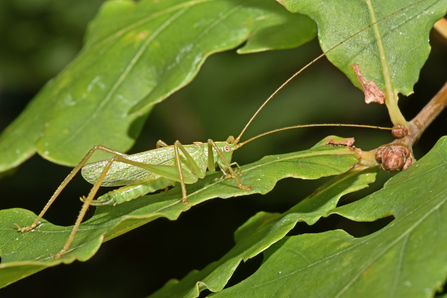
Oak bush-cricket by Gary Farmer
Oak bush-cricket Meconema thalassinum
This pale green arboreal bush-cricket flies very well and is drawn to light so it is the species most likely to turn up in people’s houses, which has led to its nickname of the bathroom bush-cricket. As with all bush-crickets, the female has a sword-like appendage at her rear end called an ovipositor, which is used for laying eggs, in this case into cracks in tree bark and leaf buds.
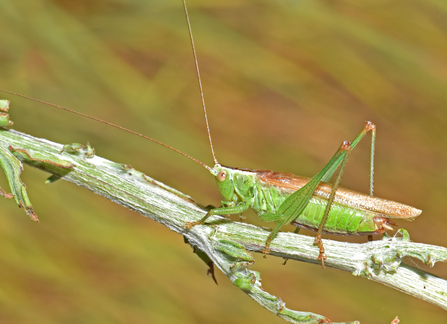
Long-winged conehead by Gary Farmer
Long-winged conehead Conocephalus discolor
This long-winged green species was first found in Worcestershire in 2003 and has spread right across the county in scrubby grassland, road verges and wetlands where it has joined its rarer cousin the short-winged conehead. The nymphs emerge a little later than most bush-crickets and are bright green with a black stripe down their back. At this stage they can be found feeding on the pollen of plants, especially buttercups.
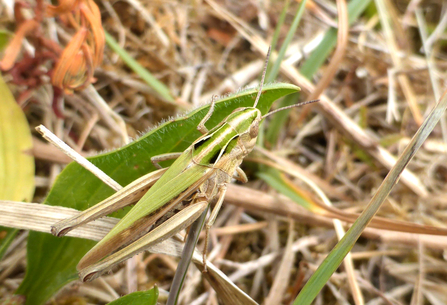
Common green grasshopper by Gary Farmer
Common green grasshopper Omocestus viridulus
Despite its name the common green grasshopper is not that common, being restricted to humid heathy grasslands and flower-rich meadows especially with tussocky grass margins. This is the species with the continuous rolling, rattling song associated with grasshoppers. Their song is produced when the insects rub their hind legs against their wings. Common green grasshoppers lay a cluster of eggs in a protective hard foam at the base of grasses.
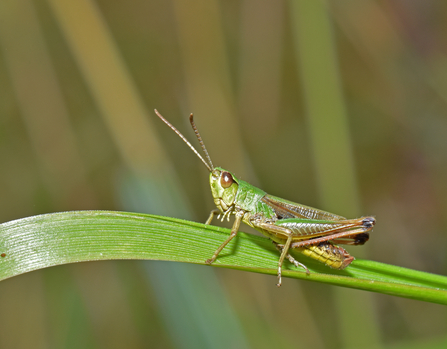
Meadow grasshopper by Gary Farmer
Meadow grasshopper Chorthippus parallelus
A very common species found in most unsprayed and uncut grasslands. The female is distinctive, being short-winged, while the smaller male has long wings. Meadow grasshoppers are often bright green with a bright yellow underside and black hind-knees. They have varying amounts of brown on their body and some even have areas of bright pink. An all brown form now occurs in the county, which can cause difficulty with identification.
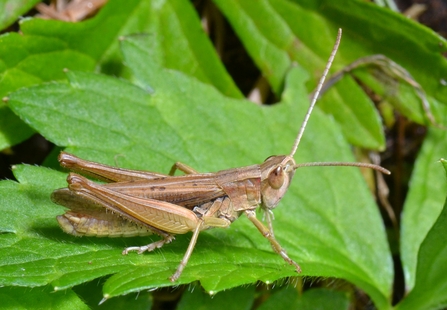
Lesser marsh grasshopper by Gary Farmer
Lesser marsh grasshopper Chorthippus albomarginatus
The first Worcestershire record is from 1993 around Bredon. Once a wetland species, it has spread across Worcestershire into the driest grasslands, exploiting grassland corridors into south Birmingham making this our most urban grasshopper. This species is usually straw coloured or dull green and lacks the bright yellow underside of the meadow grasshopper. Its range expansion has been aided by the fact that it flies very well in hot weather.
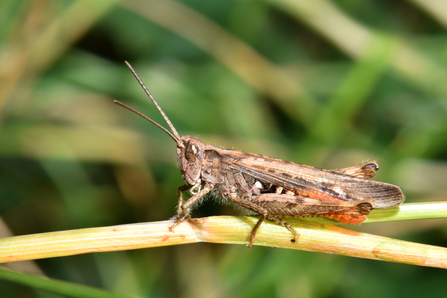
Field grasshopper by Gary Farmer
Field grasshopper Chorthippus brunneus
A large, hairy grasshopper which is usually mottled brown in colour although they can be green or even pink. This species prefers short, broken turf on, especially, hillsides and heathland where they can be found basking on the warm ground. They are quick to jump and will fly short distances when disturbed. Their song is a short chirp and males will sing against each other hoping to attract a female.

